Baseball memorabilia has transformed dramatically since its humble beginnings. What once started as game-day souvenirs have now become a serious investment opportunity for collectors worldwide.
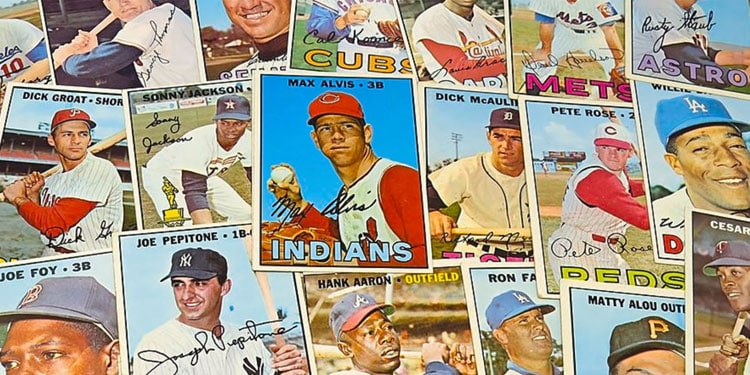
This article explores the vast spectrum of baseball collectibles beyond the classic trading cards, examining how rarity, historical context, condition, and demand shape the value of each item. Whether you are hunting autographed jerseys or century-old ticket stubs, every piece tells a story worth preserving. Understanding market trends and approaching memorabilia collecting with a strategic mindset (much like using the analysis for MLB picks) can offer not just nostalgia—but substantial returns.
Early Memorabilia and Game-Used Relics
Long before digital collectibles, game-used memorabilia was the heart of baseball collecting. Items used on the field by legends carry unmatched authenticity. A 1920s Babe Ruth bat sold for $1.68 million, while his late-career glove fetched a record $1.53 million, smashing the previous glove record set by a Lou Gehrig mitt.
Wear and tear—cleat marks, pine tar, grass stains—tell the story of the game. Home run balls are especially valuable: Mark McGwire’s 70th sold for $3 million, and Shohei Ohtani’s 50th homer in 2023 went for $4.39 million, setting a record for any ball in any sport.
The combination of authenticity, player significance, and provenance turns even a scuffed ball or cracked bat into collectible gold.
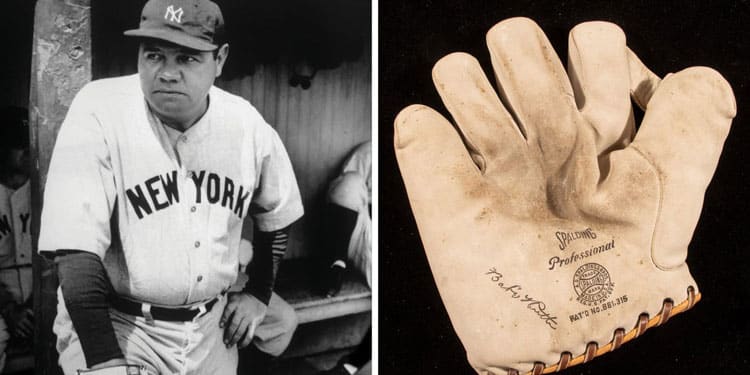
The Rise of Autographed Baseballs
As baseball’s popularity grew, autographed balls became a cornerstone of collecting. Demand is especially high for those signed by Hall of Famers and legendary teams. One standout is a ball signed by the entire 1927 Yankees, including Babe Ruth and Lou Gehrig, which sold for $632,000. Another, signed at the 1939 Hall of Fame induction, brought in $623,000.
Signature quality and placement matter. Bold, centered autographs fetch more—especially from icons like Babe Ruth, whose clean single-signed balls can hit six figures. Even unusual pairings, like a ball signed by Joe DiMaggio and Marilyn Monroe, have sold for over $190,000.
Modern stars like Shohei Ohtani and Aaron Judge are also fueling the market. Balls signed after major milestones often exceed $10,000 when authenticated.
In all cases, authentication is essential—a verified signature can turn a $20 ball into a museum-worthy artifact.
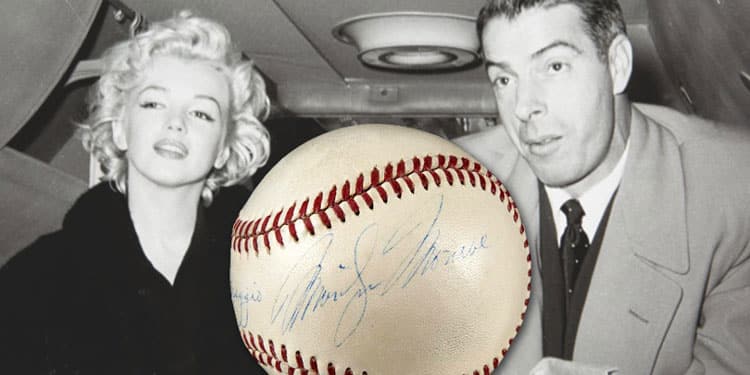
Historic Tickets and Scorecards
Before replays and YouTube, ticket stubs and scorecards were the only proof you’d witnessed history. Decades later, these fragile relics are prized collectibles—especially from milestone games. A ticket stub from Jackie Robinson’s 1947 debut sold for $480,000, a record for sports event tickets.
Programs from iconic games—like Don Larsen’s 1956 World Series perfect game—can fetch thousands. Hand-scored cards from Nolan Ryan’s seventh no-hitter or Cal Ripken Jr.’s 2,131st consecutive game add a personal, time-capsule quality that collectors love.
Condition is everything. Well-preserved examples, like a full ticket from the 1903 World Series or a Lou Gehrig Day stub signed by the man himself, can sell for six figures. These pieces offer collectors a paper portal into baseball’s most unforgettable moments.
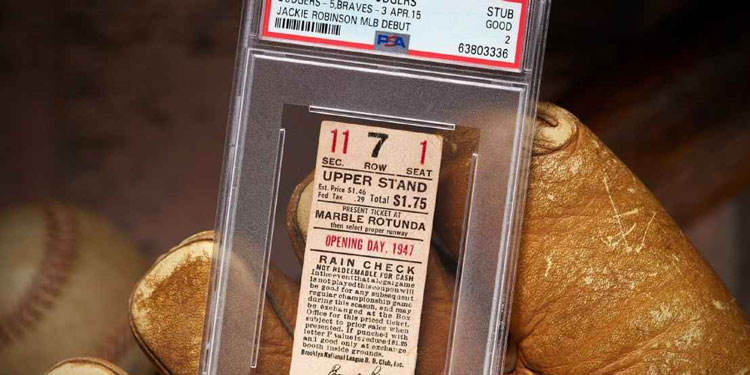
The Power of Jerseys and Uniforms
Game-worn jerseys are among the most iconic and valuable items in baseball memorabilia. A uniform worn by a legend in a historic moment can transcend sports. Babe Ruth’s jerseys dominate the record books. A road Yankees jersey from 1928 to 1930 sold for $5.64 million in 2019, and in 2024, another Ruth jersey tied to his 1932 “called shot” home run sold for $24.12 million, the highest price ever paid for any piece of sports memorabilia. That sale topped the previous record of $12.6 million set by a Mickey Mantle card.
Not every jersey reaches eight figures, but six and seven figure sales are common. A 1964 Mickey Mantle jersey sold for $1.32 million. Kirk Gibson’s jersey from his 1988 World Series walk-off home run fetched a high six-figure price due to its emotional and historic impact.
Modern stars are part of this trend. A Mookie Betts or Juan Soto jersey from an MVP or World Series clincher can reach hundreds of thousands, especially when photo-matched to a specific moment.
Authentication is essential. Collectors look for original tagging, game-use markings like dirt or grass stains, and photo evidence to match the jersey to a moment in time. The record-setting Ruth jersey had been matched to his legendary 1932 “called shot”, which fueled its value.
Today, MLB’s authentication program helps verify modern jerseys with holograms and serial numbers. A Bryce Harper NLCS home run jersey or Shohei Ohtani MVP jersey will carry documented proof of its origin. With emotional significance and verified provenance, even a piece of polyester can become a museum-worthy artifact.
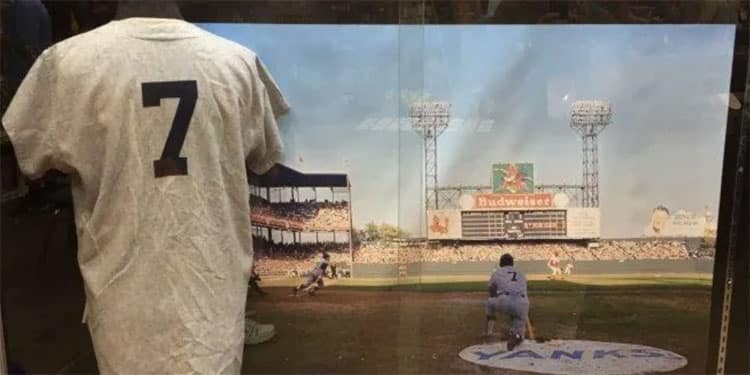
Baseball Cards Beyond the Basics
Trading cards launched the baseball memorabilia movement, evolving from kid’s toys into premium collectibles. Early cards came in tobacco or gum packs, flipped and traded by the millions. Only the few that survived in top condition now carry significant value.
The most famous example is the T206 Honus Wagner from 1909 to 1911, often called the “Mona Lisa of baseball cards.” Fewer than 60 are believed to exist after Wagner’s card was pulled from production. One sold for $6.6 million in 2021, followed by a $7.25 million private sale in 2022. Later that year, a 1952 Topps Mickey Mantle card topped them all at $12.6 million, making it the most expensive sports card ever sold at the time.
Today’s card market goes far beyond the basics. Since the 1980s, companies like Topps, Panini, and Upper Deck have introduced autographed cards, serial-numbered parallels, and rare inserts. A base card might be worth pennies, while a 1-of-1 autographed Mike Trout rookie once sold for $3.93 million.
Grading companies such as PSA, Beckett, and SGC are now key players. They score cards on a 1 to 10 scale based on centering, corners, edges, and gloss. A Gem Mint 10 can be worth ten times more than a Near Mint 8. One near-perfect 1952 Mantle graded PSA 9.5 reached the record $12.6 million price tag.
Some collectors take a more strategic approach, using the same logic used in MLB picks to guide their investments. They analyze player stats, injuries, and market trends to predict which cards will rise in value, blending nostalgia with smart speculation.
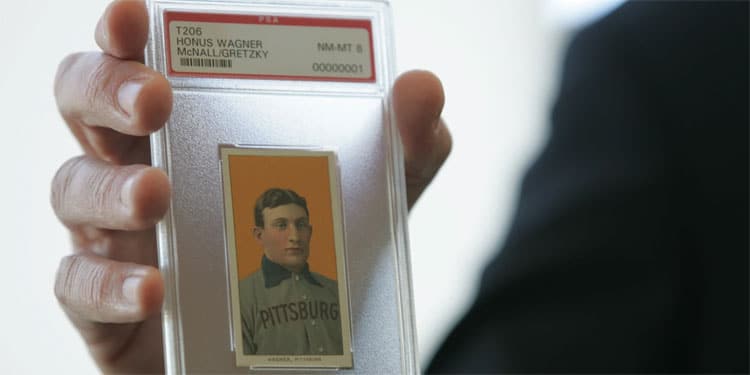
NFTs and Digital Collectibles
In the 21st century, baseball memorabilia has entered the digital age. Powered by blockchain, NFTs (non-fungible tokens) offer fans a new way to own a piece of the game. These one-of-a-kind digital assets are like virtual cards or tickets, verified as unique and limited.
MLB entered the space in 2021 with Candy Digital, releasing an NFT honoring Lou Gehrig’s “Luckiest Man” speech. This one-of-one digital piece included video, a 3D bust, and raised funds for ALS charities.
That same year, Ted Williams made a digital comeback through the Ted Williams NFT Collection, a series of nine hand-drawn cards highlighting his career. The final piece, “The Splendid Splinter,” was a one-of-one NFT bundled with Williams’ signed bat, photos, and even a stay at his former Vermont home.
This blend of digital and physical items showed how NFTs can elevate collecting. Fans could own both a digital tribute and real memorabilia from a legend.
Current players are also fueling the boom. Topps has released official NFT packs, and a one-of-one 1952 Mickey Mantle NFT sold for $470,000 in Ethereum. A Shohei Ohtani highlight NFT reportedly sold for $25,000.
These collectibles appeal to tech-savvy fans who prefer digital wallets over shoeboxes. They offer verifiable scarcity, interactive features, and in some cases, access to exclusive experiences.
While the market remains volatile, NFTs have opened a new frontier in baseball collecting. Whether it’s a World Series highlight or a digital portrait of a Hall of Famer, the hobby continues to evolve in exciting new formats.
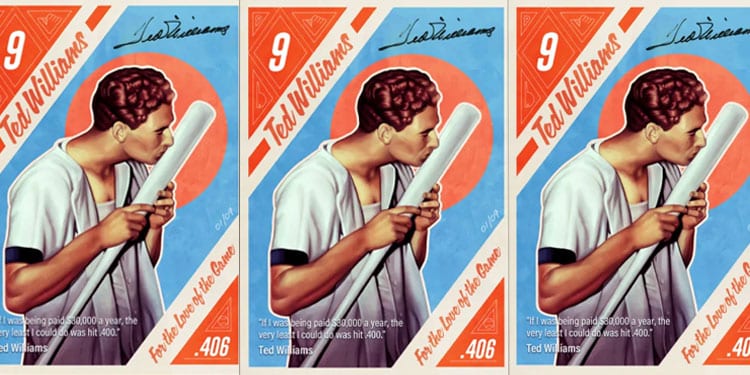
Auctions and Marketplaces
Baseball memorabilia sales have become big business. Once limited to card shops and flea markets, collectors now buy and sell through global auctions and digital platforms that move millions in merchandise.
Elite auction houses like Heritage, Christie’s, Sotheby’s, and Goldin Auctions have driven many record-breaking sales. In 2023, Heritage’s baseball category brought in $45 million. Goldin handled the $7.25 million Honus Wagner card and regularly curates themed collections that attract major bidding.
Online platforms have made collecting more accessible. eBay remains a major marketplace for everything from $10 autographs to $100,000 cards. Sites like PWCC and Goldin’s vault services allow collectors to store and trade high-end items like investments. MLB Auctions even sells authenticated game-used items, including bases, balls, and jerseys directly from milestone games.
Public sales have also set clearer pricing standards. “Comps” now guide value more than old price guides. A strong result can raise prices across the market, while a weak sale can cool it. In 2020, a Goldin auction saw a Wagner card hit $1.4 million and Cal Ripken Jr.’s personal memorabilia reach $1.2 million, including $184,500 for his final streak game jersey.
In the world of collecting, auctions set the tone. Whether in a live room with phone bidders or a digital countdown online, every sale connects passionate collectors to the game’s most prized pieces.
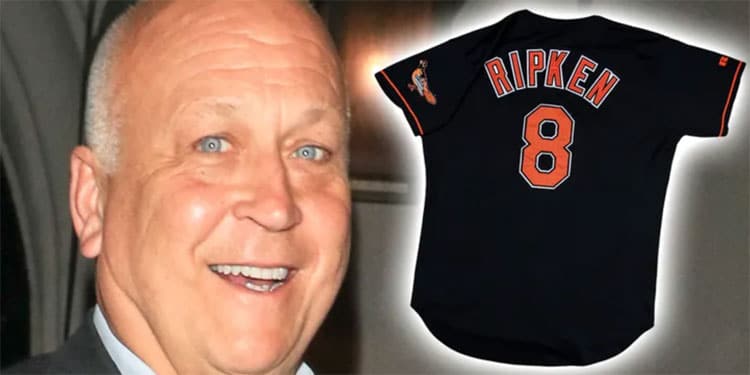
Authentication and Grading: Guarding Against Fakes
With serious money in play, authentication is essential to baseball memorabilia. For every real autograph or game-used item, there have been fakes trying to fool collectors. Third-party experts serve as the hobby’s gatekeepers, ensuring buyers get the real deal.
Companies like PSA/DNA, JSA, and Beckett Authentication verify autographs by analyzing ink, comparing known examples, and applying forensic tools. Their certification stickers or letters can boost an item’s value significantly. For game-used gear, specialists like MEARS and Resolution Photomatching confirm items were actually used on the field.
Grading is just as important. PSA, Beckett, and SGC assign condition scores to cards and tickets, with a Gem Mint 10 often worth ten times more than lower grades. These sealed grades offer both value and protection, deterring tampering and preserving trust.
The need for authentication became clear after Operation Bullpen, a late-1990s FBI sting that exposed a massive forgery ring. Experts estimated over half of autographed items from major stars at the time were fake. That scandal reshaped the hobby and led to stricter vetting by collectors and auction houses.
In 2001, Major League Baseball launched its own hologram program. An MLB authenticator witnesses the removal of game-used items, tags them with a hologram, and logs the data in an online system. A base from a playoff game or a jersey from a debut can now be tracked back to the exact moment it left the field.
Authentication also protects buyers from forgeries. From fake Shoeless Joe Jackson autographs to counterfeit vintage cards passed off as originals, grading services have helped catch frauds before they spread.
Today, nearly every high-end item includes some form of proof — grading, certification, holograms, or database records. These assurances preserve both value and trust. When you know a jersey or card is genuine, it’s more than a collectible. It’s a verified piece of baseball history.
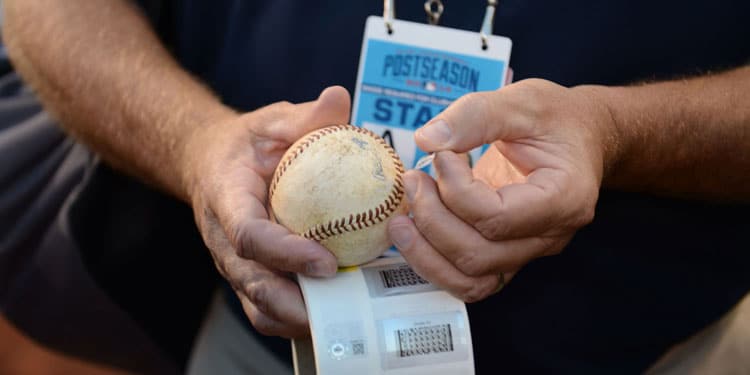
Condition and Rarity as Value Drivers
Two factors define value in baseball memorabilia: condition and rarity. A small bump in condition can mean a big jump in price. A 1950s Hank Aaron card graded Gem Mint 10 can sell for 10 to 20 times more than the same card graded Excellent 5. Even going from a PSA 8 to a 9 can raise value significantly.
This holds true across categories. Game-used jerseys with original tags, unfaded colors, and visible wear command more. Clean, centered autographs on baseballs fetch higher prices than smudged or off-spot signatures.
Rarity drives demand. Some items are valuable simply because few exist. The T206 Honus Wagner is legendary for its scarcity. Limited-run inserts, one-of-one cards, and historically rare items — like 19th-century tickets — can all carry premium value.
Error cards are another niche. The 1989 Billy Ripken “Fuck Face” card and the 1990 Frank Thomas “No Name on Front” are famous examples that remain hot among collectors.
Age alone isn’t enough. A common 1910 card may not be worth much if it’s not rare or tied to a star. Meanwhile, a modern item tied to a milestone — like a unique home run ball — can be worth thousands.
When rarity meets top condition, prices soar. Scarcity creates demand, and high-grade examples become centerpiece collectibles.
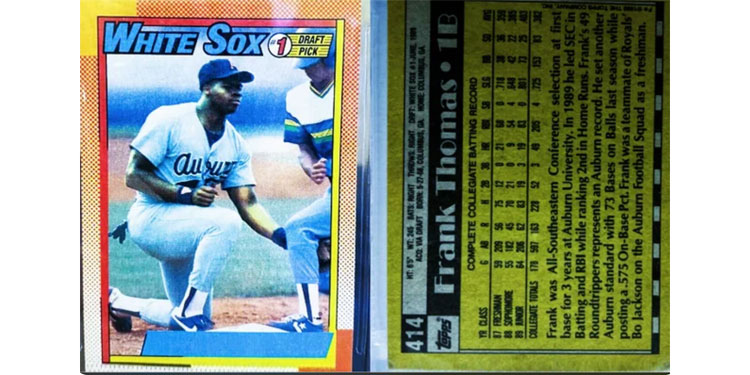
Notable Collections and Their Market Impact
Sometimes an entire baseball collection hits the market at once, creating ripple effects across the hobby. These high-profile sales often reveal rare treasures, spark bidding wars, and influence broader trends.
A strong example is the 2021 Calvin Griffith Collection sale. The former Washington Senators/Minnesota Twins owner’s memorabilia, including trophies and championship rings, brought in over $1.3 million. While the volume of items kept prices balanced, the publicity reignited interest in Senators and Twins collectibles across the board.
When memorabilia from beloved stars becomes available, prices can soar. A future Derek Jeter collection would likely cause a frenzy. Even smaller sales make waves — when parts of Barry Bonds’ collection hit the market, his rookie and record-setting gear spiked in value, along with memorabilia from his era.
These auctions can also inspire new collectors. When Stan Musial’s collection sold in 2013, Cardinals fans flocked to acquire Musial items. In 2020, a Cal Ripken Jr. charity auction raised over $1.2 million and sparked demand for other Ripken game-used gear and autographs.
Some collectors’ finds become legendary too. The Black Swamp Find — a hoard of pristine 1910-era cards discovered in 2012 — reset price expectations for vintage cards, proving that even a sudden influx of supply can raise values when quality is unmatched.
In the end, major collection sales act as market turning points. They can flood supply briefly, but often increase long-term demand by rekindling passion and shining a spotlight on a player’s legacy. Each sale doesn’t just move items — it moves the hobby.
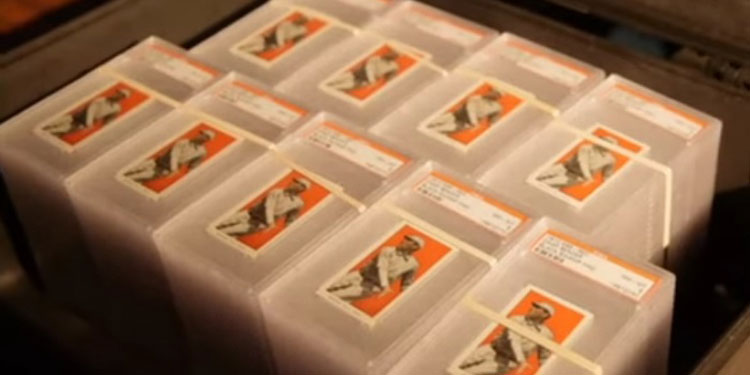
Preserving the Legacy of Baseball Through Collecting
At its core, collecting baseball memorabilia is about preserving the game’s legacy. Each autograph, ticket, jersey, or card is a tangible piece of baseball history, held and protected by someone who values its story.
Walk into the Hall of Fame in Cooperstown and you’ll see that legacy on display — Babe Ruth’s bat, Jackie Robinson’s jersey, and a Hank Aaron signed baseball that instantly connects fans to the moment he broke the home run record. These are more than artifacts. They’re storytellers.
Museums help preserve these pieces, but private collectors play a critical role too. Many items on display started in personal collections. Owning a Ty Cobb bat or a 1903 World Series program isn’t just a purchase — it’s a responsibility to protect a slice of the game for the next generation.
Top collectors go the extra mile to preserve their finds, using climate-controlled safes, UV-protected frames, and archival materials. Some even publish books or launch websites to share their collections with the world, keeping history alive whether the items are public or private.
Collecting also bridges generations. A grandfather’s card collection handed down to a grandchild comes with stories of Mantle and Mays. A parent and child discovering a Julio Rodríguez rookie card together create a new shared memory. These items become family heirlooms that capture baseball’s spirit.
Ultimately, collecting honors the past and keeps it present. Whether displayed in a museum or stored in a shoebox, each piece adds to baseball’s rich tapestry. The crack of Jackie Robinson’s bat, Nolan Ryan’s 5,000th strikeout, the joy of the 2016 Cubs — these moments live on through the objects that captured them.
By collecting, we curate history. From kids with binders to curators of archives, every collector helps keep the flame of the game burning bright for the next generation.
Brett Rudy is a trailblazer in the world of baseball. As the founder of Baseball Is My Life and co-founder of Charity Hop Sports Marketing, he’s dedicated to elevating the sport and supporting the athletes who play it. With a passion for making a difference, Brett has created successful philanthropic initiatives like Charity Wines and 100 Innings of Baseball for ALS. He’s also the mastermind behind the Corked Bat Collection, Cooperstown Classic at the Baseball Hall of Fame, and Winterball for Toys for Tots. When he’s not working to improve the game, Brett can be found playing outfield in the Boston Metro Baseball League, living and breathing the sport he loves.